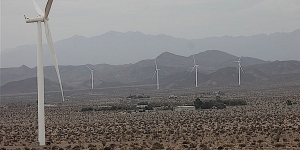READER'S EDITORIAL: GET THE POLITICS OUT OF WIND ENERGY!
Originally Published in the ECOreport
by Roy L Hales
Stanford University has just published a glowing report about how Wind Farms “can provide a surplus of reliable clean energy to society.” I almost posted it. It is important to publish information that does not fit your beliefs but, in this case, I decided to voice my skepticism instead.
“Whenever you build a new technology, you have to invest a large amount of energy up front,” said Michael Dale, a research associate at Stanford. “Studies show that wind turbines and solar photovoltaic installations now produce more energy than they consume. The question is, how much additional grid-scale storage can the wind and solar industries afford and still remain net energy providers to the electrical grid?”
According to the authors, wind turbines produce enough energy to provide three days of uninterrupted power and solar energy produces enough for 24 hours.
My problem is with the first number. The internet is full of glowing reports about wind technology and in some cases I know they are not true. There are problems the industry keeps minimizing or denying. This may serve to deflect immediate questions, but eventually destroys the industry’s credibility.
Fact: Wind turbines kill raptors. Stop burying this under statistics about the number of birds that crash into windows or get eaten by pussycats. Golden eagles do not normally crash into windows and I pity the cat that tries to eat one. Large numbers of golden eagles do get chopped up by wind turbines and they are rapidly disappearing in areas like Southern California.
Fact: There are several bird friendly turbine designs. Do they work? Are they financially viable? Is this a viable option?
Fact: Some people living close to wind turbines report they are getting sick. Studies have shown correlations between the wind farm’s distance from residences, as well the decibel levels, and the number of complaints received. That would seem to establish a working criteria. Can wind turbine syndrome be eliminated? (I do not accept the theory it is simply people’s imagination.)
Fact: Large scale renewable energy projects have a negative impact on the local environment. As result of the desert floor being scrapped in preparation for the Ocotillo Wind farm, for example, the town of Ocotillo CA has been inflicted with giant dust storms. It appears that if the solar projects proposed for Boulevard CA went forward, they may literally suck up all the water and leave the local resident’s wells dry. To paraphrase some of the complaints: why don’t you build on brown field areas where any environmental damage is already done, rather than pristine desert habitat?
Fact: Renewable energy projects are being forced upon communities that do not appear to want them. Towns like Boulevard and Ocotillo (photo at top of page) are being virtually surrounded by gigantic industrial scale wind and solar projects owned by outside corporations. Native Americans have being fighting to keep solar projects off their sacred sites in places like Blythe, McCoy Valley and Ivanpah since 2010. A similar situation seems to be occurring in Massachusetts, with the Cape Wind project.
When the American colonies revolted, back in 1776, they believed there should be no taxation without representation. They should have remained English! In the UK, local communities get to decide if renewable projects will be built in their midst. The alternative produces the lawsuits that are now occurring throughout Canada and the United States.
Fact: Though I keep reading general statements about how fantastic wind energy is, there are also reports that indicate otherwise.
The site I know the most about is Ocotillo. According to the developer, “the Ocotillo Wind project will provide enough clean and renewable energy to power nearly 125,000 homes in Southern California each year.” Unfortunately for them, one of the residents has been videotaping most of what happens and posting it to youtube. You can find them at “Save Ocotillo.” The entry for March 20, for example, records the wind speed as 2 mph and the turbines are not moving. Most videos show the turbine not moving, which would make for some pretty boring watching were it not for the occasional dust storm, foam and flooding.
Incidentally, statistics from the Federal Energy Regulatory Commission show that the Ocotillo Wind Farm was only producing 15-19% of capacity).
During a workshop in San Diego last Spring, attorney Bill Pate said that US wind farms produce “22 to 23% net capacity on average.”
According to Tom Sickenger, who writes for the Oregonian, the wind farms around Arlingyon have peak times but “produce, on average, about a third of their nameplate capacity.
Compared to these statistics, suggestions that the Cape Wind project might operate at 50% capacity sound pretty good.
Only the most important figure is missing! How much do wind projects need to produce? What is the break even point? And how much do they have to produce to be profitable? (Projections based on 100% capacity are of limited value.)
We need to know which wind energy projects are duds and what can be done to improve the situation.
In a devastating commentary entitled “Wind-Power Subsidies? No Thanks,” Patrick Jenevein of the Tang Energy Group recently explained why his company is curtailing further investment in this sector. They believe the industry is being driven by politics, rather than economics.
Government subsidies to new wind farms have only made the industry less focused on reducing costs. In turn, the industry produces a product that isn’t as efficient or cheap as it might be if we focused less on working the political system and more on research and development. After the 2009 subsidy became available, wind farms were increasingly built in less-windy locations, according to the Department of Energy’s “2011 Wind Technologies Market Report.” The average wind-power project built in 2011 was located in an area with wind conditions 16% worse than those of the average project in 1998-99.
Jenevein claims that Wind energy makes sense in Texas but not California – which is not in the “wind belt” and has only become America’s second-largest wind energy producer because of the state’s aggressive energy policies. He added that America’s current Wind Energy boom is the result of Federal grants and tax credits that enable Wind developers to recoup up to 30% of their capital investment. If there were no subsidies, developers would be more selective when they chose prospective sites.
From the little I’ve been hearing, a similar situation may be occurring in Ontario. I have yet to see the stats.
Get the politics out of Wind Energy development.
That Stanford study probably contains some valuable information, but it is difficult to take seriously until we start identifying what is working in the wind energy sector? What is not? And what we can do about it?
Photos:
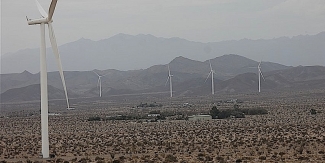 Ocotillo, surrounded by wind turbines – Jim Pelley photo
Ocotillo, surrounded by wind turbines – Jim Pelley photo
Dust storm coming into Ocotillo. Those are 435 foot high wind turbines being swallowed up – Jim Pelley photo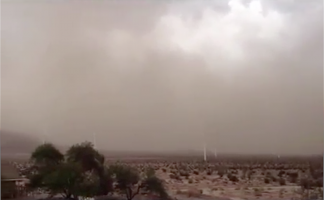
The White foam that flowed into Ocotillo, from the surrounding wind project – Jim Pelley.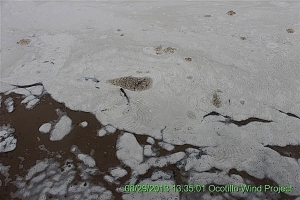
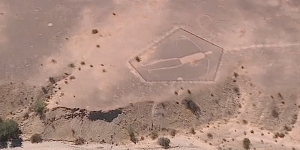 One of the Ancient Geoglyphs at Blythe CA viewed from an airplane. At least three have been destroyed in preparation for solar projects and more are scheduled to be destroyed – image from the documentary “Who Are My People?“
One of the Ancient Geoglyphs at Blythe CA viewed from an airplane. At least three have been destroyed in preparation for solar projects and more are scheduled to be destroyed – image from the documentary “Who Are My People?“
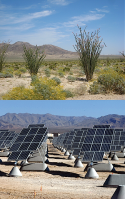 Illustration of a solar project’s negative impact on the desert. Note all the vegetation is gone from the lower photo – from Alicia Previn’s book: The Strange Disappearance of Walter Tortoise.
Illustration of a solar project’s negative impact on the desert. Note all the vegetation is gone from the lower photo – from Alicia Previn’s book: The Strange Disappearance of Walter Tortoise.
Jim Wiegand’s illustration as to why the 50m search area used for bird fatality is no longer reliable. Turbines are larger and 80-85% of the carcasses now fall outside that radius.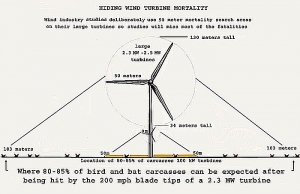
The opinions in this editorial reflect the views of the author and do not necessarily reflect the views of East County Magazine. To submit an editorial for consideration, contact editor@eastcountymagazine.org.

